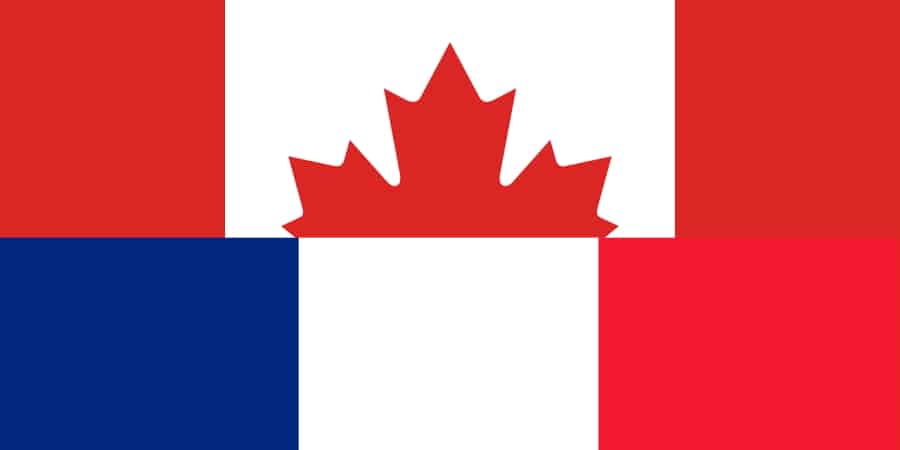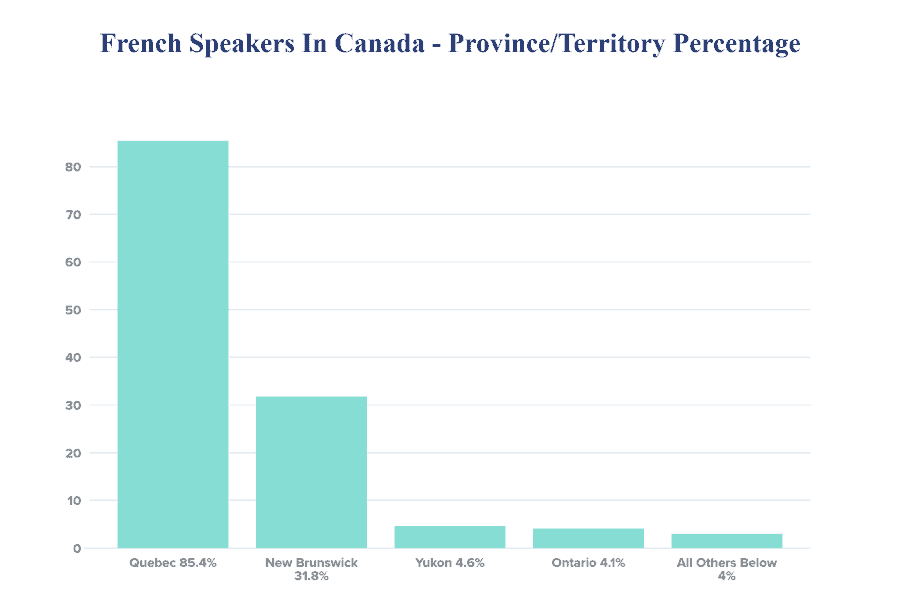
Most people know that French is a common language in Canada, but often native Canadians speak English that sounds no different from their United States neighbors. You may be wondering how often Canadians actually speak French in Canada.
Spoken French is common in about 23% of Canadian provinces and territories. Though spoken French has become less common over the years, it has recently made a resurgence with the younger population through immersions schools and language courses.
Each province or territory continues to have at least a small percentage of native French speakers, with a growing number of bilingual speakers as interest in the French language makes a resurgence. Read on to learn more about spoken French in Canada.
Contents
- 1 Common Areas in Canada Where French is a Spoken Language
- 2 Is French Spoken on Canadian Television?
- 3 Is The Common French In Canada The Same As In France?
- 4 How Strongly Do Québécois Feel About Speaking French?
- 5 Ways that Spoken French is Preserved in Canada
- 6 Final Talking Point for How Common Is Spoken French In Canada
Common Areas in Canada Where French is a Spoken Language

French speaking in Canada dates back to the early 17th century and has been an integral part of the Canadian culture since then. This is not to say that dual-languages haven’t been a challenge to Canada; according to this study, French and English protections have been detrimental to nationalism and unity.
While some areas of Canada have around 1% French-speaking residents, in other areas, French is the most common language. Throughout history, French speakers, or “francophones” as they are often called, have migrated to central French-speaking areas, with the densest population of French speakers settling in Quebec.
When we were in Toronto a few years ago, my husband ran into several people with thick French accents at local restaurants. He said they spoke little English and at least one of the workers behind the counter seemed annoyed by it.
There are two things that most Americans don’t know about the French speaking culture in Canada.
- There really are a sizeable number of people in Canada that speak French as their Native language.
- There is a tension at times between the French speaking population and the English speaking portions of the country.
Many people are bilingual and a good portion of the French speakers also speak English. That being said, French is most definitely legitimate language on the North American continent.
Have you ever wondered if French would be a fun language to learn? Well, I wrote an article about whether French is Fun to learn here.
Spoken French In Quebec

One thing that becomes very noticeable to those visiting or moving to Quebec is that French is not just spoken as one alternative in a bilingual area. This is a French speaking area of Canada and it is integral to their cultural identity.
According to Canada.ca, 85.4% of Quebec’s population is French-speaking, with 44.5% bilingual (French/ English) speakers. Quebec has the highest concentration of French speakers of any province in Canada, and much of its government, education, and media use French as its primary language.
As I noted before, this level of French may be a bit shocking to those in the U.S. since we see Canada as a primarily English speaking country. Though many know that French is spoken in a part of Canada, it is not something people take seriously until it is heard first hand.
5 Largest French Speaking Municipalities In Quebec

Montreal (population 3,519,595) – With Montreal being an officially French speaking city, it is the second largest of its kind in the world. The first being the French capital of Paris. Of the city’s residents, 68.5% claim French as their primary or native language.
Like New York’s Manhattan, Montreal is built on an island. It is actually 30 miles long and if formed by the St. Lawrence and Ottawa Rivers. Not so coincidentally, the Mount Royal Park from which the city gets its name was designed by Frederick Law Olmsted. He was also one of two designers of New York’s Central Park.
It wasn’t always the largest City in Quebec, but today it is the largest and the center of the French speaking population in Canada. When most people think of French in Canada, Montreal is the first place that comes to mind.
Ottawa – Gatineau (population 989,567) – The area around Ottawa is also called the National Capitol region. The city of Gatineau is separated from the Nations Capitol by the Ottawa river. Though it is in the province of Quebec and Ottawa is in Ontario, many think of them as the same area.
Gatineau itself has a population of 276,245 making it actually Quebec’s third largest city and French speaking population. Yet, in reality it is inextricably connected with the city of Ottawa.
Other than good dining, Canada’s most visited Museum (The Canadian Museum of History), and the city’s many festivals, Gatineau is known for its French speaking population. With the size of its population and the larger urban environment, French speaking locals won’t be hard to come by.
Quebec City (population 705,103) – Officially the second largest population center in the province of Quebec, Quebec City in another hub of French native speakers and French Canadian culture. Here you will find that 95% of the citizens speak French with 80% of them doing so as their primary language.
Due to the historic nature of the old town of the city, ‘Old Québec’ as it is called is a UNESCO World Heritage site. It boasts a 400 year long history and is known as the original site of French in North America.
It has the designation of being the first Catholic parish north of the Spanish settlements far to the south. The French sent many missionaries to convert the native populations and helped establish the Western Culture.
Sherbrooke (population 139,565) – Originally growing as an industrial town producing machinery and textiles, Sherbrooke has transformed into an educational and administrative hub. Its industrial roots are still in tact, but it has expanded into the lucrative electronic parts manufacturing arena.
With its university focus comes an attraction for the artistic community. There are many museums and cultural attractions for those interested in the more aesthetic cultural experience. There are more than a couple theatre groups and an symphony orchestra.
The French language is front an center in this bilingual town. There are two daily newspapers that provide a snapshot of the prominence of French. One is in English and the other all in French. The French paper La Tribune is one of 25 French language publications in Canada.
Trois-Rivières (population 114,203) – This medium sized urban area located half way between Montreal and Quebec City is known for its poetry, music, and French culture. The ‘old city’ has been designated an historical district and during the warmer times of the year it is closed off to traffic and transformed into a pedestrian only zone.
With many French language schools, a major university giving classes in French, and the large French speaking population, any visitor or new resident will not have any problem finding the language. Not only is French common among the residents, it is part of their unique culture.
The French name of the city, Trois-Rivières translates to ‘three rivers’ in English. Its name designates its culture and people as the francophones that they mostly are. Though there are exceptions, the French Canadian language and culture is a main component of daily life.
Other Areas in Canada With Spoken French
There are controversies in politics not only on political issues, but even about the French language in Canada. In New Brunswick a controversy arose over elected officials and their French language skills. It is a cultural as well as a language issue.
French In The New Brunswick Province
Though no other Canadian province is as intentional about spoken French as Quebec, you can still find residents who speak French as their primary language in other areas. Next to Quebec, New Brunswick comes in second when it comes to spoken French in Canada.
A sizable 31.8% of the New Brunswick population claims French as their “mother tongue,” with 34% speaking both French and English. New Brunswick recognizes both French and English as the province’s official languages, and many day-to-day interactions are written and spoken in both languages. (Source: Office of the Commissioner of Official Language)
French In The Ontario Province
The northern portion of Ontario has high levels of French speaking citizens. Though the tallies are unofficial, many claim that half of the residence in this area choose French as their primary language. Since this is not an a designation of the government of Ontario, no official statistics are readily available.
There is a move by the government of Ontario to foster the French language. French Immersion schools are funded with the same funding as English language schools.
Quebec and New Brunswick are the only provinces with a notably high concentration of French speakers. All other provinces have a large majority of English speakers, with less than 5% of their population speaking French.
In total, this amounts to nearly 8 million French speakers in Canada, enough that Canada names both French and English as its official languages.
Is French Spoken on Canadian Television?
Though the budgets for original television series from Quebec won’t have the budgets that many English shows do from the United states, the French spoken in these shows is being presented in ever better written story lines and acting that improves year by year.
There are many channels and shows the are totally in French in Canada. Most of them center on Quebec and the surrounding French speaking provinces. Here are just four examples.
- District 31 – This is a well done police drama that tops the list of many in Quebec.
With well over 300 episodes and over a million viewers per episode, this is Quebec’s most popular television show. The episodes run a half an hour long and air four times per week. Many that watch it to learn French or as a native speaker find it fairly addicting.
Not only will you get the French as it is spoken in Quebec from this show aired on ICI Radio-Canada Télé, you will also experience (and probably miss some of the meaning behind) French Canadian cultural references. It is well written and could rival many of the U.S. police dramas past and present.
The series started on French television in 2016 and shows no signs of slowing down. You should be able to watch it for language learning or for connecting with the French you already know for years to come.
Like-moi! – This is a unique sketch based comedy show that uses satire to poke fun at millennials and the internet culture in general.
If it is more universal cultural references that you are looking for, only wrapped in the French language, Like-moi! is a perfect fit for you. The comedy is not always laugh out loud funny, but the talented acting and comedy will surely bring smiles and chuckles. (Do French smiles look different than English ones?)
It airs on Télé-Québec and has been a long running, popular show since 2016. The French language can be directly tied to the culture from which it comes in Canada, with many references that can go over the head of Anglophones trying to either learn the language or culture.
Not with this series. The writers here masterfully point out the absurd parts of general millennial culture and how people are weird overall. If you are looking for big personalities and well done comedy skits, all wrapped in the French language, look no further than this Canadian television series.
- Fugueuse – An adult themed television drama about a teen girl that gets tricked into prostitution by a human trafficking ring.
This is not a show for the kids, but is an example of a French Canadian attempt at edgy drama that is currently running. The show comes from the TVA lineup. The theme of human trafficking is the center of the episodes with acting that is believable and for our purposes here… in French.
For parents of girls this may be a bit hard to watch as it doesn’t simply give a portion of the French Canadian culture to viewers. It offers a realistic portrayal of the dangers posed by organized nefarious groups that can affect the lives of families no matter the culture or language.
For a show that takes itself seriously in the French language, this show makes observations about the darker side of humanity that applies not just to French speaking Canada, but to the world as a whole.
- Faits Divers – In the quirky style of Fargo comes this French Canadian Police show about hapless criminals and their exploits.
The setting for this at times black comedy is the North of Montreal. You will hear French as it is spoken in Montreal and be exposed to the French culture in Canada with all of its nuances.
To truly learn a culture, you need two things:
- Its language
- Its humor
Here you have both rolled into one unique package. This has been a popular show by ICI Radio-Canada Télé since 2017. The comedy is not for everyone and definitely not for the whole family, but for those so inclined, it is a good option for learning or experiencing French from Montreal.
All three of these shows are popular examples of French used daily on Canadian television. These can also be watched nearly everywhere in Canada, even though they are based in Quebec. Is there French on Canadian television? You bet there is.
For those that are looking to learn French, one of the best ways is through immersion. Yes, these types of shows if you can find them to watch can help, but for those at the intermediate level or below, these could be a difficult endeavor.
I would recommend a great site that uses current videos with synchronized subtitles and exercises with each video. Yabla French is a great resource for anyone wanting to learn French for the first time or brush up on the language.
Is The Common French In Canada The Same As In France?
The type of French spoken in Quebec has slight variations from more traditional French. In fact, it has enough variations that Quebec residents have their own name for it, Québécois. Since early in Canada’s history, Quebec residents have fought for French to be the primary language in their province, and today it is readily accepted. (Source: Babbel.com)
The difference here is a bit stronger than something like the dialect from the northern to the southern United States. Yet, for the French speaking natives in France, it will definitely be different from what they are used to.
One reason for this is the isolation of the French speakers in Canada from the French spoken in France. This happens to many languages. Most notably is the English divergence from its Germanic roots. With the isolation of English on the islands of Britania, it evolved differently than German.
This same thing happened with Canadian French. English had strong influences from French, Spanish and others making it take a different course than German over the centuries. French in Canada was influenced by English as well as aboriginal words and phrases.
All of this led to the French you hear from a French Canadian varying noticeably from the French from citizens of France. This comes in the form of words, phrases, some vowel pronunciations, and grammatical usage. Someone speaking either type of French will be able to communicate fairly well with the other, but the differences will be obvious to each.
How Strongly Do Québécois Feel About Speaking French?
In 1977, the Quebec government created two organizations whose sole purpose is to preserve the French language in Quebec. Residents can file complaints to these organizations if they believe their rights to be “informed and served in French” are not respected. (Source: Publications Québec)
There are also laws about working environments for employees. Every citizen of Quebec is entitled to do the entirety of their job in French. This means everything from speaking, to computer software, to written documents and correspondence.
If a job has to be done in another language for business or governmental purposes, it is up to the employer to prove that this is the case.
These are fairly staunch protections for the rights that the French speaking employees in the province of Quebec enjoy.
This is more than just wanting to have your kids know of the culture of your past. Being able to demand to be served or work in French speaks to an active preservation of a living culture. We are not talking about nostalgia here. This is something much deeper.
Ways that Spoken French is Preserved in Canada
Over the years, Canada’s areas with dense French-speaking populations have often found it challenging to preserve their language. Due to so many surrounding English-speaking provinces and their proximity to the United States, the English language threatened to remove French from Canada altogether.
Canadians who valued the French language had to get creative and advocate for their native tongue to remain. They created councils, government groups, and social movements to preserve French in their areas. One of the most effective and popular methods for preservation has been the French Immersion Schools.

French Immersion Schools
Much like ever-popular Spanish immersion schools in the United States, French immersion schools teach French by immersing children fully into the language. From Kindergarten all the way until they graduate high school, children will learn in the French language.
In Kindergarten and through all of the primary level, students learn all of their instruction one hundred percent in French. This means all of their core subjects like math, reading, writing, history, and science are taught to them in French, even if their first language is English.
Around 4th grade, children begin learning in English for a small percentage of their day. That percentage slowly increases throughout their educational career until they are learning in half English and half French each day. The immersion process has been shown to be highly effective in forming a new generation of French speakers who continue to preserve the language in Canada. (Source: Canadian Parents for French)
Other Ways Spoken French is Preserved
Beyond French Immersion schools, which have become increasingly popular, there are other ways that Canadians have advocated and kept the French language an integral part of Canadian culture.
These groups and measures often face resistance from Canadians who see French as unnecessary. While not every Canadian is passionate about preserving the French language in their country, these groups and measures work to make it accessible to those who feel it’s important.
Advocacy Groups
In recent years, advocacy groups have formed to fight for French’s continued use as a dedicated language in Canada. Some of the groups are:
- Canadian Parents for French
- Francophone Association of Municipalities of Ontario
- Impératif français
- Commission nationale des parents francophones
- Fédération nationale des conseils scolaires francophones
- Fédération des jeunes francophones du Nouveau-Brunswick
Each of these groups works towards promoting and preserving spoken French in Canada. Some are specific to the province in which they were formed, while others are generalized to the entire country of Canada with chapters in each province or area.
Charters
Several charters have been created and amended throughout the years that have provided further opportunities for French-speaking Canadians. Some of these charters include:
- Charter of the French Language
- Charter of Rights and Freedoms
- Official Languages Act
While not every charter that is proposed is successfully adopted by the government body, they act as a way to advocate to retain the French language and give equal rights to those who speak it.
Government Interventions
Canada has designated both English and French as its official languages. This constitutional designation means that the federal government must conduct any official business in both languages and provide support to those who may be in the language minority in their province.
Each of these groups and measures provides a space for spoken French to continue and thrive in Canada. While spoken French in Canada has seen some steady growth over the last 30 years, the growth is not proportional to the overall population increase there. It will be interesting to see if the French language will continue to grow in Canada or eventually decrease altogether.
Final Talking Point for How Common Is Spoken French In Canada
Spoken French is a significant part of Canadian culture. While spoken French is a minority in most of Canada’s provinces, there is a large majority of French speakers in Quebec and a sizeable number of French speakers in New Brunswick.
Many people work hard to ensure that the French language is protected and will continue in Canada (FYI: I’ve addressed tips to learning French, too). The government has put policies in place to ensure that French speakers will be treated equally to English speakers and have access to the same resources.
French immersion schools and other educational pursuits allow for younger generations to carry on the culture of speaking French in Canada. Not everyone in Canada wants the bilingual status to continue, but those that do continue to advocate for it.
Source: Canada.ca
